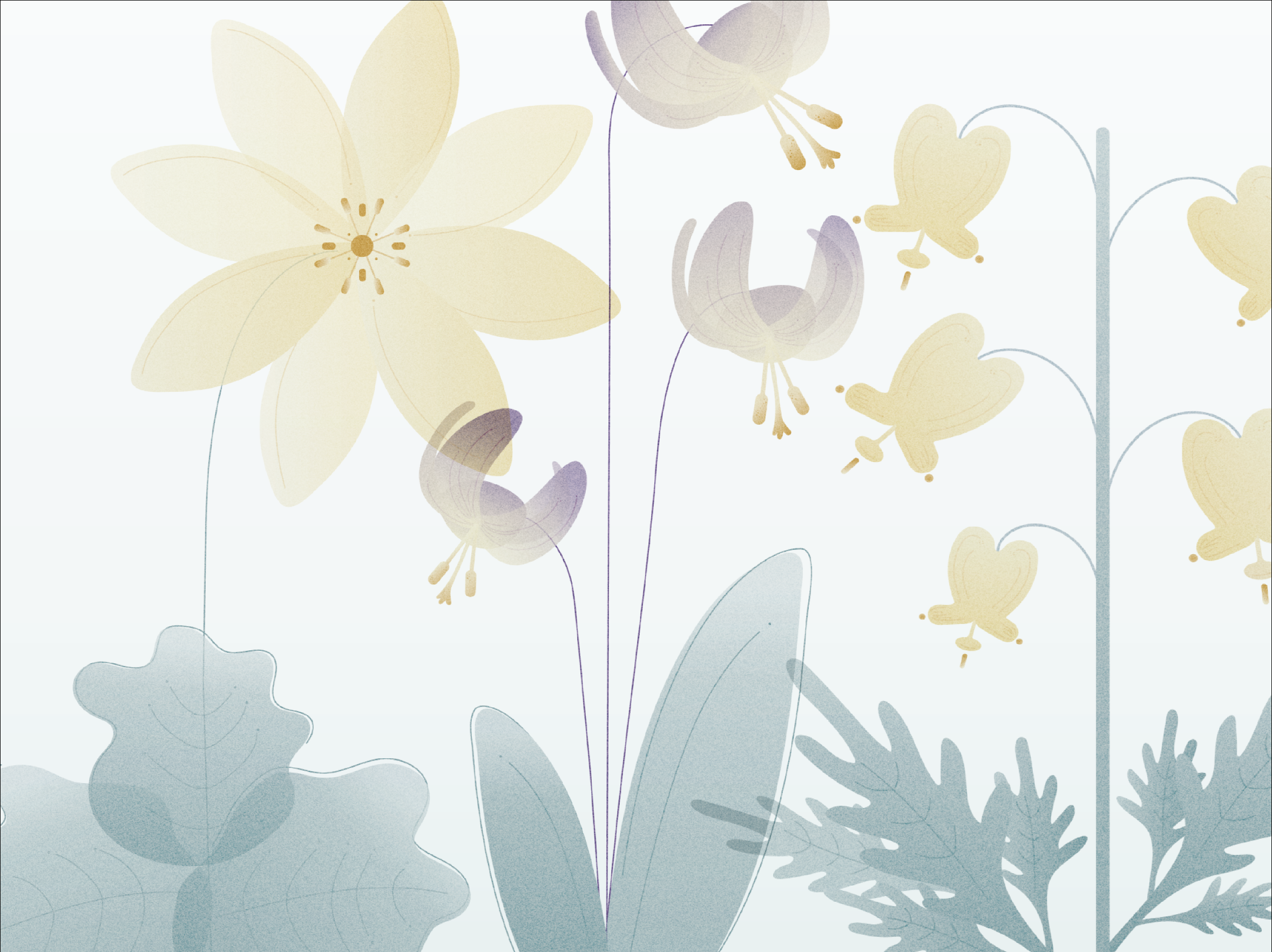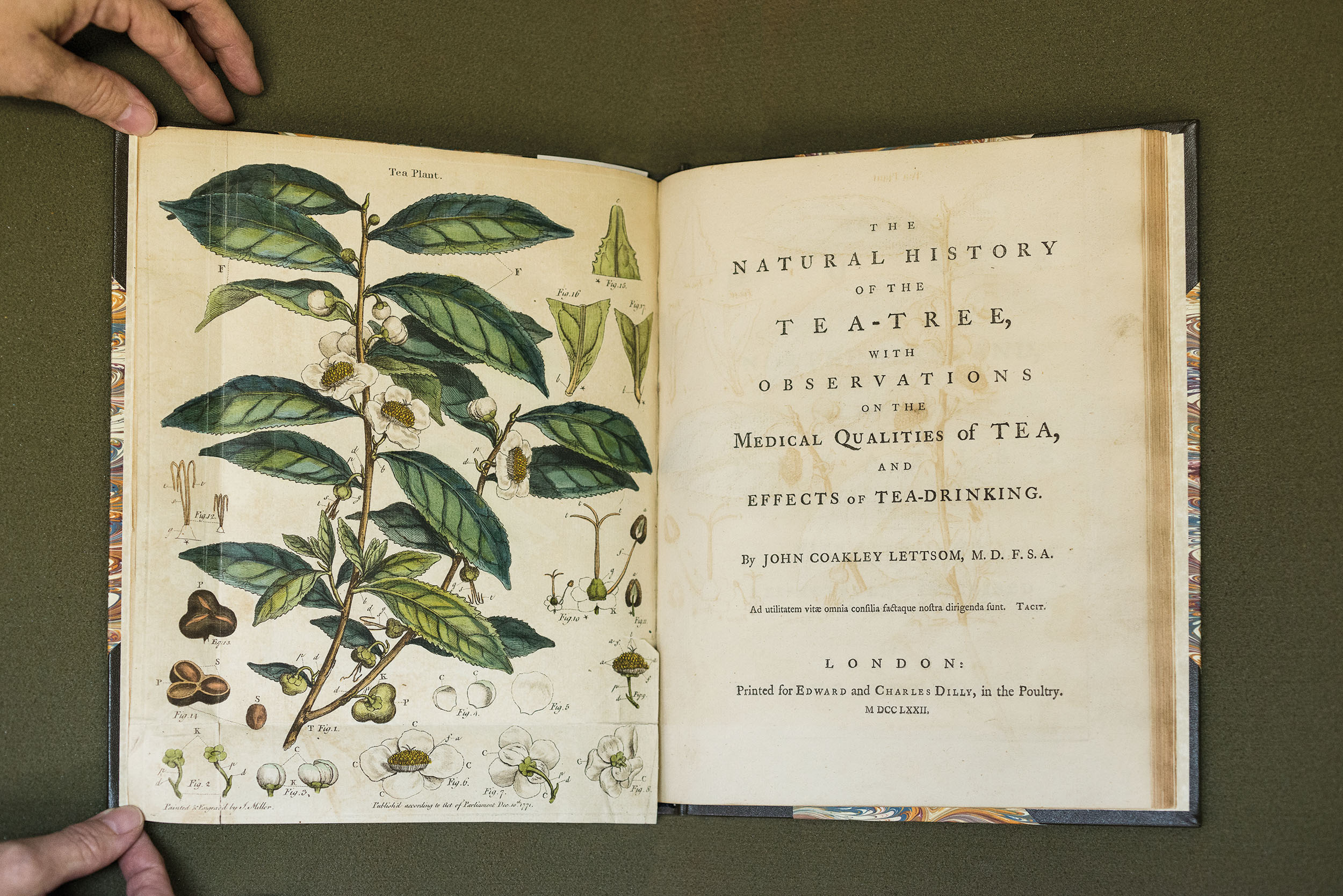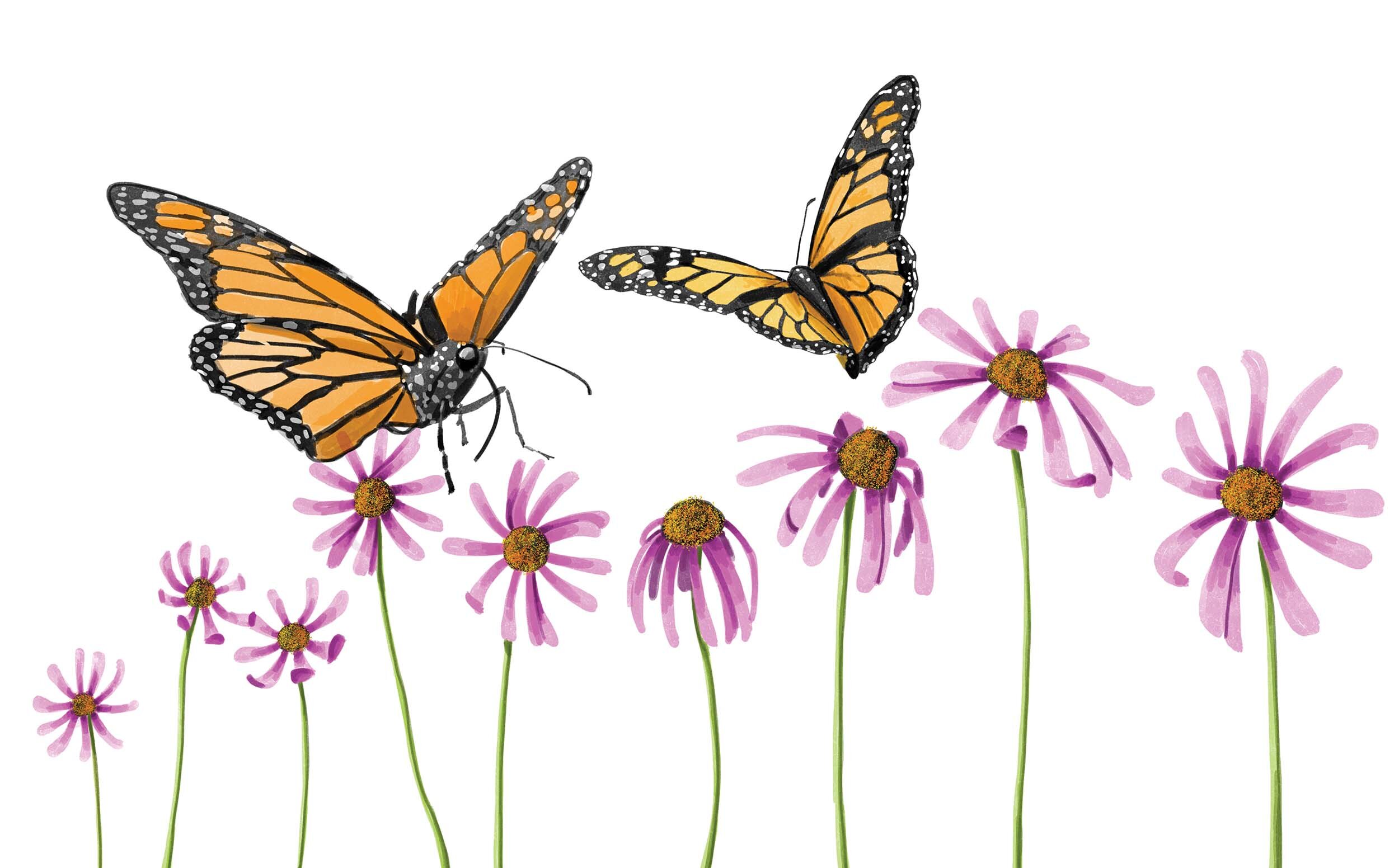Wild in the City

Illustrations by Youjin Bae
At their Evendale home, Ruth and Stan Trosset established a sanctuary for native wildflowers. Now, Gorman Heritage Farm has given these important plants a new home.
The browns and grays of winter’s fallen leaves and bare bark predominate, but there’s pale green at ankle height. Early buds tip twigs; throughout the woods, we see the yellow flares of daffodils and winter aconite. To the untrained eye, it’s a tangle of limbs, but as we move deeper in, my guide pauses to mark out a seldom-walked path with branches downed in a recent storm. Moss, lichen, and fungi effloresce in the filtered light. From the leafy floor, tiny blooms of white, yellow, pink, and purple are beginning to emerge.
My guide is former Gorman Heritage Farm director Sandra Murphy. It’s a Saturday morning in March, the weather unable to decide whether it’s lion- or lamb-like. We pull into the driveway of an unassuming house on Glendale-Milford Road. Lugging a bucket, gloves, pruners, and a shovel, we make our way into the adjacent wooded lot. They’re the sort of woods you see, if you notice them at all, that edge many a suburban neighborhood—here today and chopped, chipped, and carved up for new construction tomorrow.
This particular wood was much loved by one local couple, Ruth and Stanley Trosset. Stan was a paper engineer at Miami University; Ruth a research chemist at the University of Cincinnati until children Carol and Michael came along and she became both a stay-at-home mom and keen-eyed chronicler of the wildlife at their doorstep. They built the house in 1955, the year after they married, and later bought two adjoining lots. It was Stan who originally had the idea to collect and plant native wildflowers on the property.
Gathering & Documenting
Carol remembers spending spring breaks with her family hunting native wildflowers. They delighted in watching wildlife and the seasonal successions of buds and blooms. For 43 years, Stan, often accompanied by his wife and children, combed woods and visited the sites of planned development around the region, relocating more than 80 species of native plants—and in the process, creating a sanctuary.
“When we brought back new species, we would discuss micro-habitats to think about where that species was most likely to flourish,” Carol says. “We learned how to identify the species. We all gave a high priority to seeing and watching natural things—nesting birds, baby rabbits, waking up during the night to listen to an owl, or seeing how a praying mantis ate a grasshopper.”
Ruth Trosset filled notebooks with observations of the life of the woods and of native wildflowers. “She recorded when they broke ground, when they budded, when they bloomed, when they went to seed, and when they died,” Murphy says. Beginning in 1956, she recorded 122 species of bird, 50 trees, myriad details of the seasonal lives of mammals and insects, and the intricate interplay between native plants and climate. She kept at it until 1987, when declining health limited her to observations at bird feeders. Such phenological data—how climate variations affect the lives of plants and animals—is now understood to be essential to studying climate change. Murphy mentions a 2013 New York Times article on how researchers have used Henry David Thoreau’s notebooks to determine that plants he observed in the mid-1800s are flowering earlier today, indicating a climb in average temperatures.
In the late 1990s, the family gave the two wooded lots to the Cincinnati Nature Center. “We treated the woods with great affection and respect, but we never used words like ‘preserve’ or ‘sanctuary’ until we decided to give the property to CNC,” recalls Michael. “By then, all four of us had developed a strong sense that the land should be preserved, and that the wildflowers were what really made it special.”
Today, the Trosset family no longer owns the home, and while the sanctuary remains, it is inaccessible to the public. So a project is underway to relocate many of the native wildflowers to a new preserve at nearby Gorman Heritage Farm. That effort, headed up by Murphy, received a $10,000 grant from the Greater Cincinnati Foundation’s City Gardens Fund this year. Which is why we are here on a cool spring morning. Murphy is on the hunt.
She lets out a hoot of delight.
“Yes! Trout lily!” We drop to our knees to examine a pair of purple-mottled leaves and a stem pushing up through the forest floor. From the stem hangs a single white and violet blossom with petals curling back and skyward to reveal a hanging yellow stamen. The white trout lily, or “fawnlily,” grows in colonies on forest floors in the eastern U.S. and Canada. Colonies can be hundreds of years old, spread by runners and by seed. Trout lily is just one of many spring ephemerals concealed in this soil, part of the succession of intricate, fleeting flowers that Ruth Trosset keenly anticipated and detailed in notebooks she bequeathed to Carol.
We clear detritus from the base of the lily, then cut a circle into the surrounding soil, taking care to avoid the bulb. We stow the plant in Murphy’s bucket.
To call the Trossets’ sanctuary a hobby would be to diminish it. They worked hard to manage the trails and cull invaders. Stan would open the fridge in his office to find native wildflowers left there for him by colleagues. And the family got calls whenever development threatened local flora. As land was cleared for the Cross County Highway, the Trossets rescued Dutchman’s breeches and squirrel corn. Green dragon came from a tract of land flooded with the creation of East Fork Lake.
Biologists to whom Carol Trosset has shown Ruth’s data have been intrigued by its rigor and thoroughness, despite having been recorded by an amateur naturalist. Ruth’s observations stretch to before the 1970s when changes in phenology were first becoming apparent. Ruth also “documented multiple taxa in a single location,” Carol says. “Most such data sets include only birds, or only wildflowers.” Ruth’s scientific mind found stimulation in the sanctuary’s interconnected web of relationships.
Carol has just begun to analyze Ruth’s data, but even at this stage, she says, “there is clear evidence of bloom dates getting earlier for a variety of wildflower species.”
While she cautions it’s impossible to predict how relocation will disrupt the plants, the new sanctuary will provide better protection, access, observation, and an opportunity to build on Ruth’s record-keeping.
Murphy pauses to clip some daffodils—not a native species, but pretty, nonetheless. They’ve taken a beating from blooming with unusually early spring warmth followed by a deep freeze. Unlike these daffodils, native wildflowers have adapted to survive the vicissitudes of our Midwestern climate. Some will lie dormant for years until a change in their environment triggers them to re-emerge.
As we walk through the woods, she gives me a mental map of what lies sleeping beneath fallen leaves. Here, she says, you’ll soon see bloodroot. There: mayapple. Near the back of the property, away from the road: Solomon’s Seal.
But there are also swaths of a non-native lesser celandine, a spreading perennial from the buttercup family that crowds out the native wildflowers, that Murphy and the Trossets made their mission to preserve. Moving along these remnant pathways is an object lesson in the encroachment of suburbanites’ imported landscape plants and other invasives. Left unchecked, many can easily spread, disrupting the succession of wildflowers that are integral to our region’s natural biodiversity. Along with the celandine, Murphy and I pause to clip back and attempt to uproot multiflora roses and myrtle. The aggressiveness of ornamentals and ground-covers-gone-wild is undeniable evidence of our influence on ecosystems. We are responsible for these intruders. To deny our part in all this is irrational and nonsensical, a form of nihilism. But in acknowledging that we set this chain of cause and effect in motion, a project like the Trosset Wildflower Sanctuary relocation shows we have the power to counterbalance our influence.
This morning Murphy is also scouting where to direct the eight AmeriCorps volunteers who will visit the following day to help gather plants for relocation and wage war on invasive species. As we leave, we see evidence that someone has been cutting locust trees at the edge of the sanctuary. Murphy is concerned they may have entered the preserve. We bag up some rubbish and head to Gorman Heritage Farm.
Re-Making the Sanctuary
The Greater Cincinnati Foundation grant provided a financial infusion that has supported the design, layout, and enclosure for the new sanctuary. For this initial work, Murphy enlisted former Gorman Heritage Farm employee John Hemmerle and his ecological landscape company Our Land Organics. Just west of the farm’s bee hives, Hemmerle constructed a 10-foot deer exclusion fence with an impressive gated entry that will soon be flanked by a pair of dogwoods. He plotted a circular path that follows the contour of the hillside and bridges seasonal run-off stream beds that converge within the sanctuary.
Hemmerle’s approach is not just to relocate a bunch of plants from the Trosset property, but to create an ecosystem. Healthy native growth will ultimately keep weeds and invasives at bay. Murphy and her volunteers have done a spectacular job of eliminating old, established honeysuckle, but Hemmerle is all too aware that wild mustard, grape, and residual honeysuckle remain threats. The goal is to assemble a healthy native landscape with a succession of growth that will offer few footholds for intruders.“The idea is to have ‘green to green,’ a living mulch of plants touching plants,” he says. “So you create protection for the soil and shade out at least some sun-hungry weeds.”
The Trosset Wildflower Sanctuary at Gorman Heritage Farm formally opened on April 30. It’s a modest-sized lot compared to the Trossets’ original place, but a Herculean project when you compare it to the honeysuckle-choked hillside out of which it has been eked. Not that this keeps Murphy from thinking big—she already has designs on the adjoining hillside. She plans to assemble a group of “Friends of the Wildflowers” volunteers to tend to the sanctuary and to make it self-supporting through sponsorships of shrubs and trees planted around its perimeter.
We clear the ground and dig a hole roughly the size and depth of the bowl of earth we removed from the Trossets’ land. Along with the lily and its bulb there’s some moss and a couple of critters—a relocated section of the forest floor. It settles easily into the depression.
On the hillside above the new sanctuary, looking out over the industrial Mill Creek Valley, it occurs to me that in relocating a trout lily, we’re no different from the ants that carry its seed. We enjoy a symbiotic relationship with a flower that is a source of delight and potentially so much more, in the hidden links between our lives.
In the struggle to survive, all beings draw from an ancestral pool of genes, adaptations, skills. From past experience we divine what the future holds. So even in the tiniest acts of preservation, we shape our destiny.
Thanks to the work of Amos Gorman and his grandchildren, Ruth and Stanley Trosset and their children, and Murphy and her volunteers, here grows a place to pause and wonder. And perhaps, like Ruth Trosset, to take note. You might compare her recordings to your own. Or, like Thoreau at Walden Pond, find a mirror for your soul.
Ever since his grandfather put him to work squashing potato bugs and shoveling compost in a vast organic garden north of Philadelphia, Cedric has loved the outdoors. These days, he squashes bugs for his green-thumbed partner, Jen. His writing has appeared in Saveur, Cincinnati, This Old House, and Belt magazines. He is the Collector at the Mercantile Library Downtown.





